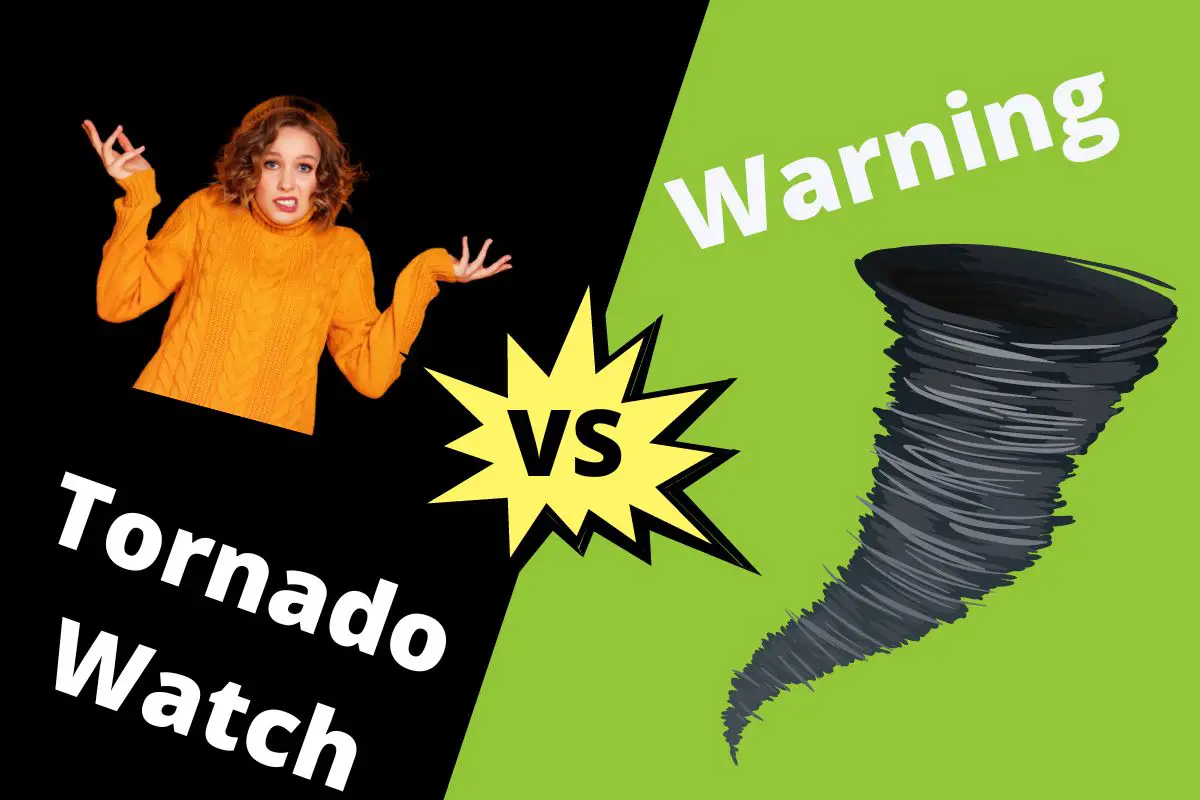A tornado watch means there are favorable conditions for a tornado to form. However, it may not occur. A tornado warning means a tornado has been sighted on the radar, and immediate action is a must.
Weather forecast officers commonly use these two different terms to issue notices. However, these terms often confuse many people.
Here’s the difference between a tornado watch and a warning so that you can interpret these statements and prepare accordingly.
Table of Contents
Tornado Watch vs Tornado Warning
| Tornado Watch | vs | Tornado Warning |
| Possibility of tornado formation. | MeaningIssued By | Tornadoes are detected or spotted nearby. |
| NOAA’s Storm Prediction Center (SPC). | Issued By | National Weather Service (NWS). |
| 4 to 8 hours prior | Duration 4 to 8 hours prior Half an hour prior |
Half an hour prior |
| Large areas | Issued For | Local areas |
| No immediate action is required; however, preparations can be made. | Type Of Action Required |
Immediate action is required, along with safety measures. |
What is a Tornado Watch?
When the atmospheric conditions start worsening, and weather conditions become suitable for a tornado, a tornado watch is issued. However, it doesn’t mean that a tornado is imminent.
Two Types of Tornado Watches
- A Tornado Watch means that weather conditions favor the formation of tornadoes in thunderstorms.
- The Severe Thunderstorm Watch means that conditions are favorable for developing severe weather over the next few moments.
During a tornado watch, there isn’t any action required on the part of the general public. But, you should stay aware of the weather condition.
A tornado watch is generally issued by NOAA’s Storm Prediction Center (SPC) hours before.

What to Do During a Tornado Watch
Although a tornado watch doesn’t necessarily mean that a tornado is going to strike soon, you must know what your next steps should be.
Tips for Preparing for Severe Weather
- Prepare a handy emergency kit for every family member.
- Keep all your devices charged, along with portable battery backup.
- Keep a constant eye on the local news channel regarding weather updates.
- Contact your family members who are outside.
- Keep all the loose items inside your house.
- Identify a safe spot in your home away from the windows, possibly under the staircase or basement, where you can take immediate shelter.
What is a Tornado Warning?
A tornado warning is more severe than a watch. It’s issued when weather professionals detect a devastating tornado on the radar.
Tornado warnings are issued a few moments before the storm hits, mainly including the location and possible destruction path (towns and cities). This severe situation calls for immediate action from the public.
A tornado warning is issued by the local National Weather Service (NWS).
Tornadoes occur in many parts of the world. However, North America is more vulnerable to them.
Waterspouts
A waterspout is a tornado that develops over or moves from land to water. On the other hand, a landspout is a tornado that doesn’t arise from organized storm-scale rotation or a thunderstorm that is not a supercell.

What to Do During a Tornado Warning
Once a tornado warning is issued, you should know what to do, whether at home, in a car, or outdoors.
If You’re at Home
- Collect all the emergency kits.
- Take immediate shelter in a safe spot. Though it’s the lowest floor of a sturdy building, you can also seek shelter under any sturdy furniture, like a dining table away from the windows and door.
- Do not leave the safe place until you receive the safe signal from the weather department.
If You’re in the Car
- Try to drive to a sturdy building to seek shelter.
- If you cannot find a building, park your car, get out of it, and follow the outdoor safety measures.
If You’re Outdoors
- Lie flat and face down on the ground to protect your head.
- Never take shelter under a bridge or a tree. It might fall and cause more significant harm.
What’s the Difference Between Tornado Watch and Warning?
Here are the fundamental differences between the two to give you a brief understanding.
Definition
A tornado watch means that tornado formation is possible due to favorable weather conditions. However, it doesn’t mean that a tornado will certainly happen.
On the other hand, a tornado warning means that a severe tornado is detected on the weather radar. A warning is generally issued for a small area.
Issued By
Tornado watches are issued by NOAA’s Storm Prediction Center (SPC), and Tornado warnings are issued by local National Weather Service (NWS) offices.
Duration
A tornado watch is generally issued for 4 to 8 hours, while warnings are issued for around 30 minutes.
Impacted Area
A tornado watch is issued for large areas where the condition favors the formation. In contrast, tornado warnings are issued for smaller areas where a tornado is detected on radar.
Type of Action Required
A tornado watch doesn’t require immediate action. However, one can prepare in advance. If a tornado warning is issued, you must take action and seek shelter.
Tornado Watch vs Warning
You’ve probably seen the devastation caused by tornadoes on your news app. Perhaps, you’ve experienced it.
Unfortunately, this natural disaster is unstoppable, but we can save ourselves by preparing in advance. This is why tornado watches and warnings are important to understand.
If you’ve enjoyed learning about the difference between a tornado watch and a warning, check out our post comparing magma and lava.

